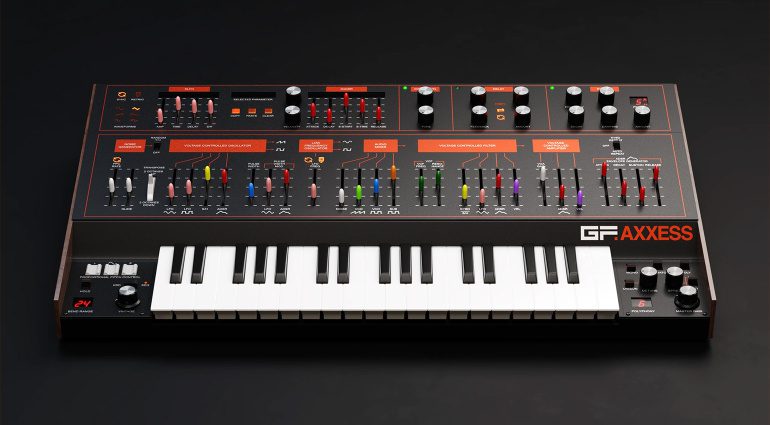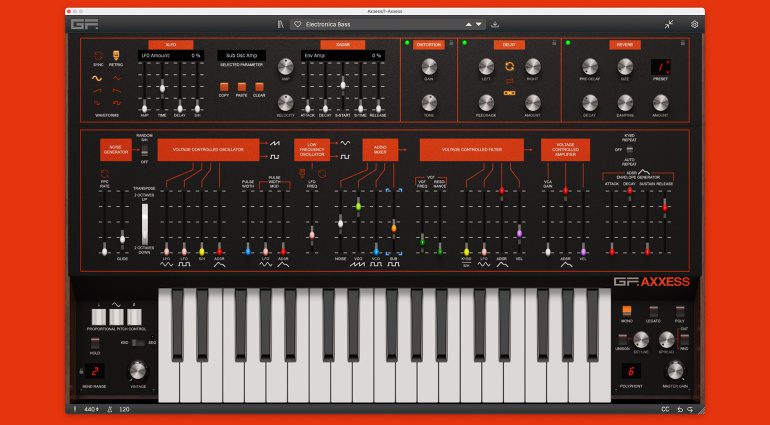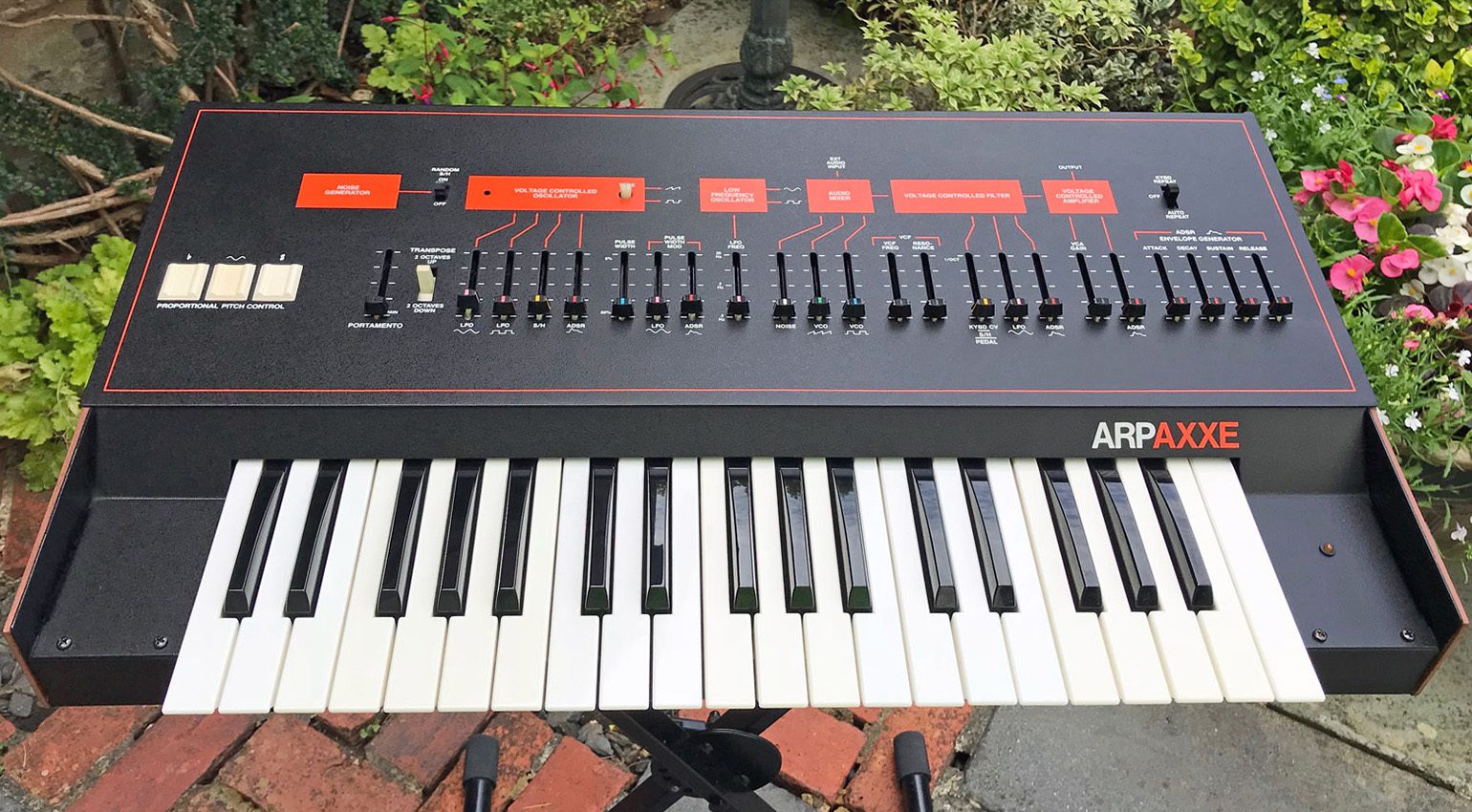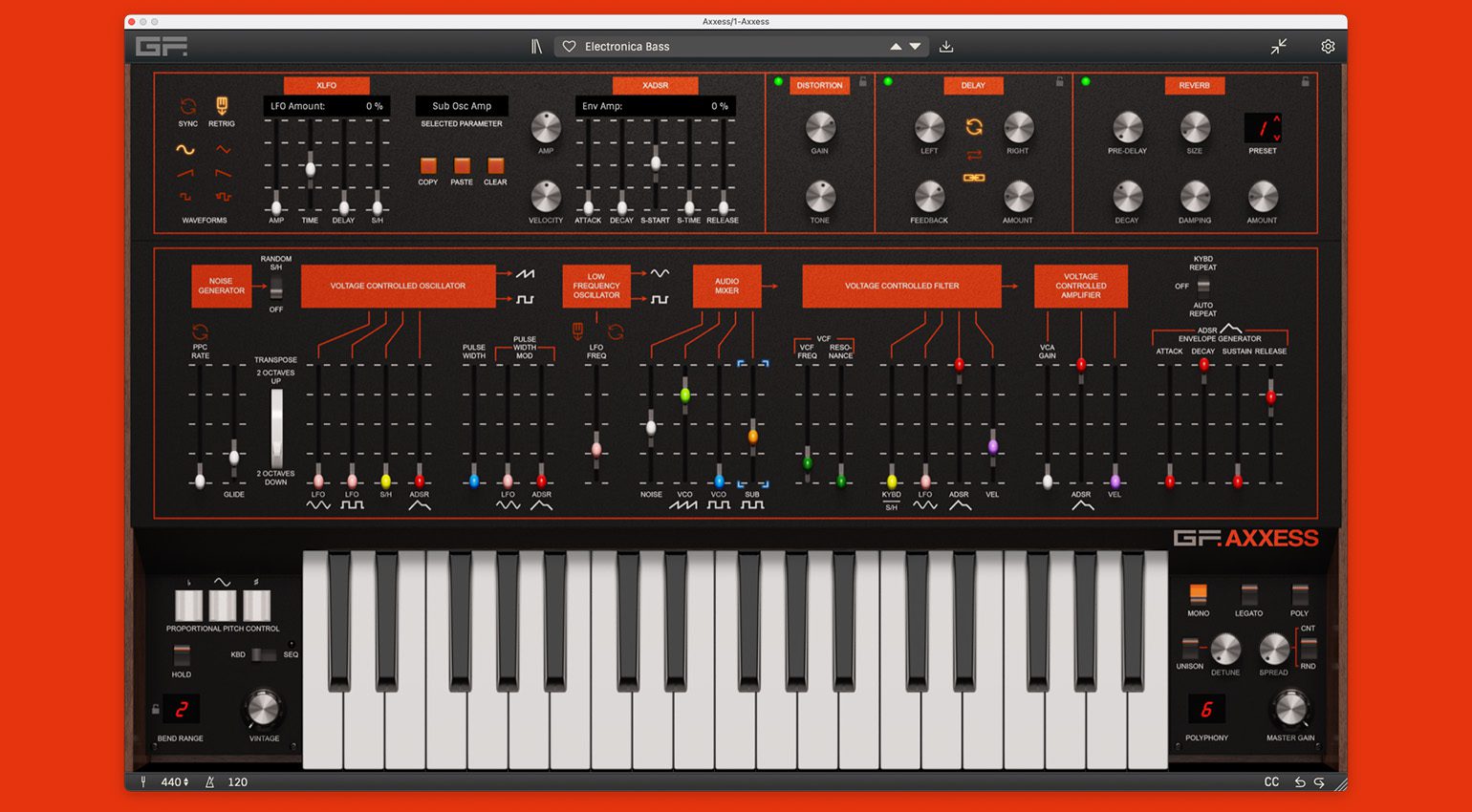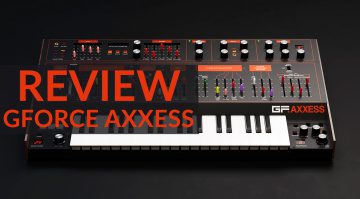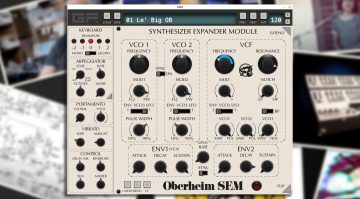GForce Software Axxess – A Big Baby Oddity
GForce Software Axxess is a surprise software recreation of the lesser-known ARP Axxe. Is this worthy of a software-based immortalisation? Read on to find out…
GForce Software Axxess – Standout Features
- Software recreation of the ARP Axxe
- Fully-scalable UI
- Efficient Preset Browser
- Arpeggiator and straightforward 16-step sequencer
- Distortion, Stereo Delay & Matrix Reverb effects
- Vintage knob for authentic analogue imperfections
- Monophonic, Monophonic Legato, and 6-voice Polyphonic modes
- Vast modulation options via X-Modifiers
Sneaking this in just before the Holidays, GForce Software gives us Axxess, a cute but deceptively large synthesizer in all but its size. This delightful homage to the Odyssey’s baby sibling takes this single oscillator, single filter synth and gives it the GForce treatment. This means a careful balance of authenticity and bringing the wee beastie up to date. But first, some history…
The ARP Axxe
Released in 1975, the ARP Axxe was basically a cut down Odyssey. It had a very simple and basic architecture that consisted of a single oscillator, a single filter, a single envelope generator and an LFO. It was akin to, but preceded, an SH-101 or CS-01 in that it stripped everything down to basics. And in doing so, gave budding synthesists access (no pun intended) to a quality instrument.
The first version of the Axxe followed the design cues of the Mk.II Odyssey with its black and gold panel and thick wood end cheeks. Shortly after, it adopted the Mk.III Odyssey colour scheme of black and orange. It also inherited the buck-toothed keybed that caused panic amongst keyboardists and their roadies!
Looking back over ARP’s legacy, the Axxe never gets much love and, to be perfectly honest, when GForce contacted me a while back and invited me to try it, I was perplexed as to why they would bother with something so ‘off the radar’, if you will.
If I’m honest, I was expecting a significant update to one of their existing instruments. That one will have to wait for another day. So, how does Axxess compare to the “Oh-Gee” as the kids say these days? Let’s take a look and have a play…
You are currently viewing a placeholder content from YouTube. To access the actual content, click the button below. Please note that doing so will share data with third-party providers.
The Interface
The ARP Axxe was a pretty sparse affair and the Axxess does not build on that too much. When you first launch the synth, the extra bits are automatically revealed at the top. This section contains the now-obligatory XLFO and XADSR that we have seen on a number of new GForce synths.
There’s also some basic effects that include distortion, delay and reverb. As with previous outings, these FX are simple but incredibly good. No frills, no fuss, just perfectly suited to the instrument.
Below this we have the familiar ARP-style layout. As well as a few additions to give us velocity control over the filter and VCA, anyone familiar with the Axxe will feel right at home. Once more, and presumably inspired by Alan R Pearlman’s penchant for colour-coding controls, the faders have coloured tips that correspond to how their settings affect others of the same colour. It’s a brilliant paradigm that I’m sure Alan himself would approve of.
Underneath that is the keyboard area. To the left are the familiar PPC (Proportional Pitch Control) buttons as well as a switch to select keyboard or sequencer triggering. There’s also the now common sight of a ‘Vintage’ knob. Like all others, it introduces a degree of de-calibration to various components to simulate an aged machine.
To the right of the keys are the mono/legato/poly switches and unison mode and spread controls. The Axxe was, as you’d expect, a monosynth. The Axxess delivers six voices and that alone makes this a FAR more interesting synth than the hardware original.
If you pop the Extended features screen away, you are left with a supremely simple synth to navigate and, just like it’s forebear, makes for a great tutorial synth. That’s one thing I always loved about the likes of this, or the SH-101. The simplicity of the interface allows beginners to get their heads around basic, subtractive analogue synthesis. The Axxess is no exception.
The Sound
In terms of sonic quality, the Axxess does not disappoint. Fans of the Oddity will know exactly what I mean. GForce have done remarkable work in recent years when it comes to faithfully nailing down that analogue sound. One of the first things I do, and I don’t know why, is check the filter. I drop the oscillator(s) down to zero, whack the resonance up and see if it self-oscillates.
And, oh boy, the Axxess does not disappoint here. All sorts of fun can be had with this filter and it becomes very musical, quite quickly.
The oscillator itself is big, fat and punchy and when you flick the Unison mode switch, it becomes ballistic. Again, the simplicity of the controls makes Axxess a huge amount of fun for very little work kinda synth. It is instantly rewarding and grin-inducing.
The added sub-VCO really adds some body to any sound. This square wave sits one octave below the main oscillator and is brought into play via the Audio Mixer section. It’s a brilliantly useful and simple tool.
Opening this up to six voices of polyphony now makes the Axxess’s architecture really flow. I half expected it to be paraphonic, but no, this is fully polyphonic, as per the Marc Doty measure of Polyphony vs Paraphony! There is a pretty unique character to a single oscillator polyphonic synth and Axxess has it in spades.
You are currently viewing a placeholder content from YouTube. To access the actual content, click the button below. Please note that doing so will share data with third-party providers.
Performance & Sound Design Features
GForce’s excellent XLFO and XADSR features are once again implemented here. These extend the LFO and ADSR way beyond the capabilities of the ‘factory’ LFO and ADSR and can be used in a range of creative ways to further expand and embellish your sound. But one of the most fun things about Axxess is the inclusion of the step-sequencer.
This is very ARP-like in design and is just incredible fun to play with. Sequence length can be anything between one and sixteen steps and the sliders can be used to change note or velocity values.
There are plenty of settings to mess around with that allow you to craft your sequences, such as Swing or Mode as well as Scale. The Sequencer mode can switch to Arp mode so that your sequence can now be controlled by the notes you play.
My Thoughts
I’m not going to lie. When I first opened Axxess up, I was slightly underwhelmed. I guess that over the last couple of years, GForce have been giving us some huge instruments to play with. The likes of OB-E, Minimonsta 2 and OB-X have really spoiled us when it comes to great analogue emulations.
So on initial plays, the Axxess felt somewhat lacklustre. But I am the first to admit when I am wrong and I was VERY wrong about Axxess. What really flicked the switch was the sequencer mode. Dialling through some of the presets switched on a light in my head and all of a sudden, Axxess began to make sense.
I think one of my biggest faults is to approach most synths from the perspective of playing chords. Whilst Axxess is six voice polyphonic, and it does pads and textures really well, where it really excels is allowing that meaty oscillator shine through on a per-note basis.
And that filter. Man, that filter. Having had my head wobbled by that, the paddy stuff then becomes more interesting. I imagine that Axxess will predominantly be used for bass and leads, but the additional voices will allow you to make those sounds flourish more.
Hats off to the sound design team too, here. There are some really great presets included, all presented superbly via GForce’s new patch browser.
More Information
GForce Software’s Axxess is available now for an introductory 50% off price of $41/€45/£39.99.
GForce Axxess runs as a standalone application, as well as AudioUnit, AAX, VST and VST3 on macOS and AAX, VST and VST3 on Windows.
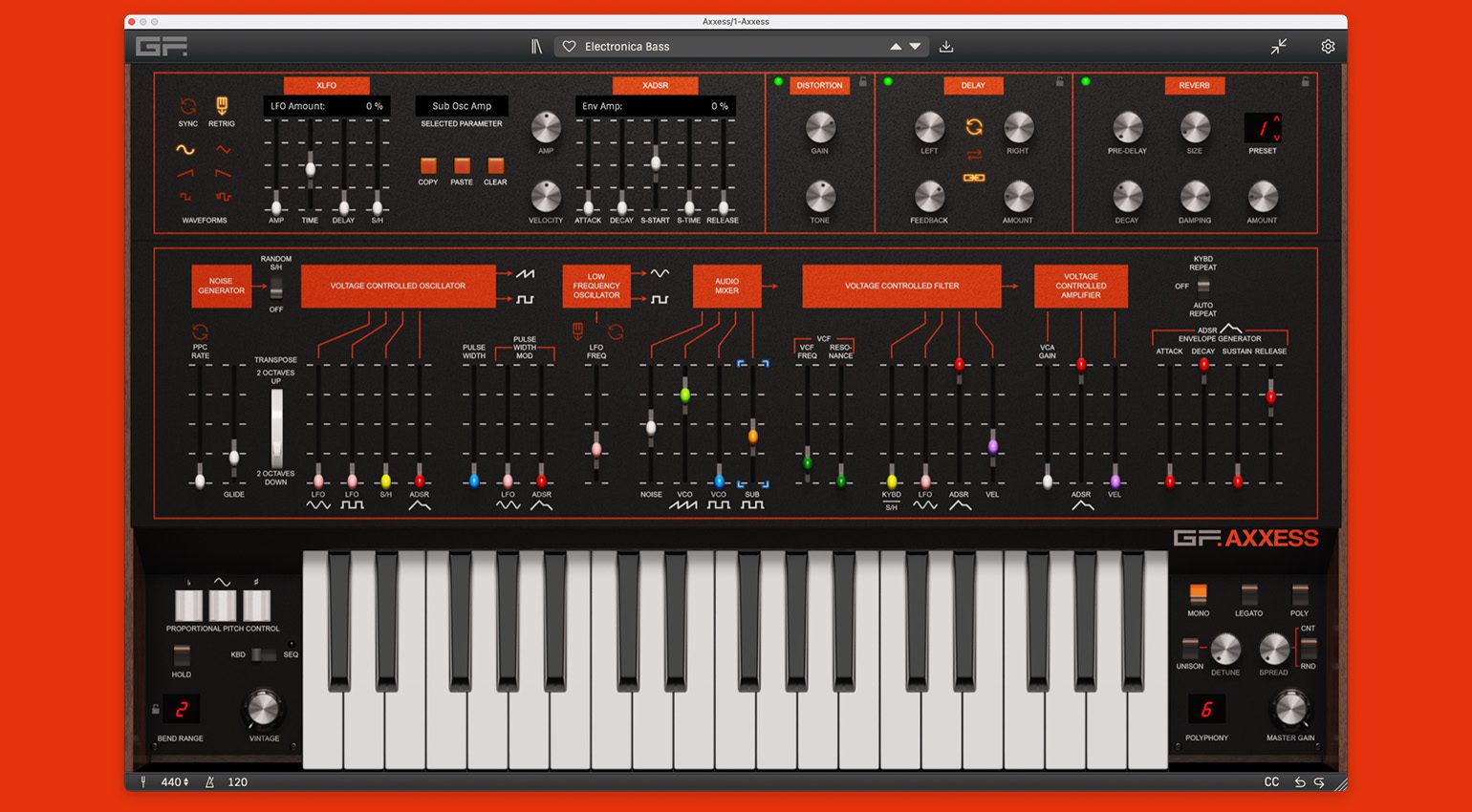
- GForce Software’s Website
- More from GForce Software
- Alan R. Pearlman Foundation
Note: This article contains affiliate links that help us fund our site. Don’t worry: the price for you always stays the same! If you buy something through these links, we will receive a small commission. Thank you for your support!
 4,8 / 5,0 |
4,8 / 5,0 | 